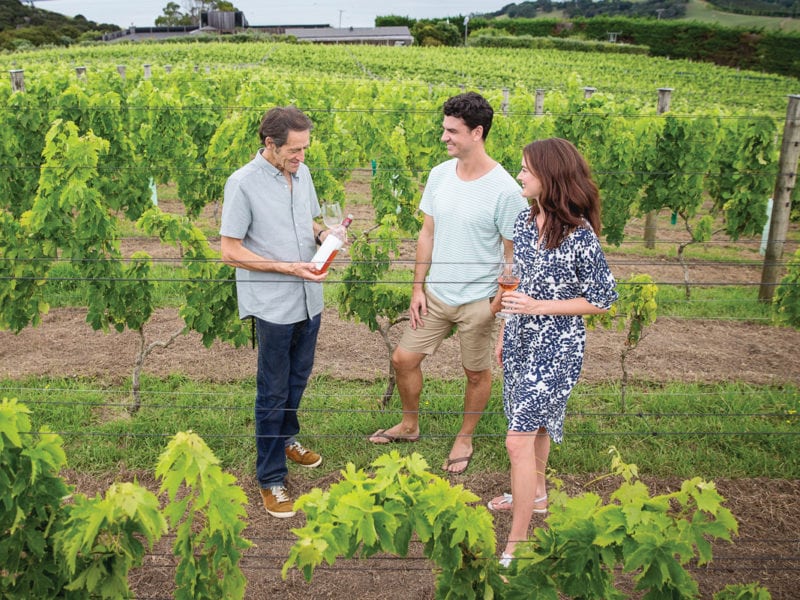
No Reservations about Recommending NZ ― But We Wish We Had Made More Of Them
New Zealand (NZ) is tough to get to from Ohio. For wine lovers ― not to mention those who would like to soak in some of the most stunning topography on the planet ― it’s worth the effort. I discovered NZ’s charms in the early 1990s when I tacked a week onto an Australian sojourn. It wasn’t nearly enough time.
Back then I wasn’t aware of NZ’s emerging wine regions but was fortunate enough to happen upon some extraordinary Sauvignon Blancs from Marlborough. Since then, many of NZ’s appellations (called Geographical Indications or GIs) have become renowned and accessible, from Hawke’s Bay and Gisborne to Central Otago.
Last spring, I had the opportunity to return to New Zealand with my husband. We knew it would be challenging to see as much of the North and South Islands as possible in two-and-a-half weeks, including wineries scattered among its 18 GIs. So we decided to sample wines from as many areas as possible at meals and visit wineries if convenient to other excursions on our must-see list, such as the Maori Arts and Crafts Institutes in Rotorua, the Waitomo Glowworm Caves or Milford Sound.
Twenty-plus hours after departing, we spilled into Auckland. Mercifully our first host, Bart Blommaert, whisked us to the well-appointed Ascot Parnell Boutique B&B in the chic Parnell neighborhood. Bart and his wife, Therese, take superb care of incoherent arrivals. We ate a hearty breakfast with other guests from Singapore, Austria and Canada, then decamped to their elegant balcony to doze and savor views of downtown and Waitemata Harbor.
The next few days we recovered from jet lag by island-hopping around the Hauraki Gulf. On our hosts’ recommendation, we caught a bus to Auckland’s ferry building and headed for Waiheke (pronounced “Why-hee-kee”) Island, known for its abundant wineries and great beaches.
We wanted an overview of this 36-square mile paradise, so we boarded a Fuller’s “Explorer” bus and got the 75-minute grand tour about the island’s history, wineries, flora and fauna. Meanwhile, giddy people kept climbing aboard as we picked up tasters.
Waiheke is home to some 20 wineries, many of which are estate wineries. The island is covered with vineyards and olive groves. The vineyards are primarily planted in red French varieties such as Syrah, Merlot, and Cabernet Sauvignon, as well as white varieties, particularly Chardonnay and Pinot Gris. Waiheke’s Bordeaux-style reds are ripe, full-bodied and considered some of the best in New Zealand.
Stonyridge Estate’s Larose is a Cabernet-dominated blend that has an international reputation. Other notable producers are Destiny Bay Vineyards (Magna Praemia), Obsidian Vineyard, Peacock Sky, Man O’War (Dreadnought Syrah), Cable Bay, Mudbrick and Te Motu.
Many of Waiheke’s wineries also offer fine dining experiences in their restaurants. Some are so popular, such as Cable Bay’s 5-course “garden-to-table” pairings with wine or Mudbrick Vineyard and Restaurant, visitors should reserve before arriving in Auckland or risk being disappointed.
We were among the disappointed, so we consulted our fellow easy riders on the bus and came up with a plan: head to the town of Oneroa Beach and go to the Waiheke Wine Centre to taste a variety of local talent; then buy some to take to the Oyster Inn to accompany NZ’s famous Bluff oysters, described as briny and sweet with a tangy metallic finish.
The Waiheke Wine Centre is a nice retail store with seating on a balcony overlooking the town beach. It has an Enomatic system dispensing 2-oz. tastes and boasts a wide variety of Waiheke wines ranging from Destiny Bay’s Mystae 2013 to reasonably priced Syrahs, Waiheke’s most common red. We enjoyed the Mystae, but our favorites were the Merlot blends such as Man O’ War’s Ironclad 2012 and Tantalus Estate’s Merlot Cabernet Franc 2014. Dinner across the street at the lively Oyster Inn was disappointing due to desultory service. Our lamb dishes were great (NZ has more sheep than people) but we never got our Bluff oysters because we had to catch the ferry back to Auckland.
If we’d had more time, we would have returned to Waiheke armed with reservations at Tantalus or Mudbrick’s restaurant, had a leisurely lunch with wine pairings and spent an afternoon lingering on its pristine beaches. But we marched farther south to Rotorua, then Wellington and down to the South Island’s hotbed of outdoor activity, Queenstown. Most of the excursions we wanted to take weren’t conducive to side winery visits. But our last day in Queenstown we ran out of energy —even the will to take pictures. So we signed up for a tour of four Central Otago wineries. With the exception of Akarua, which makes some delightful sparkling wines, we thought the hype about Central Otago was just that. That said, we didn’t get to Felton Road Winery, which Andy Peay of Sonoma’s Peay Vineyards had recommended to us. (Peay grew up in Ohio and worked at Felton Road in a previous incarnation.)
Alas, Felton Road accepts only those visitors who have an appointment.
Thus, the moral of this story regarding New Zealand wineries is this: Add an extra week and make no small plans — only detailed ones with reservations at the hottest destinations.
For more information, see www.newzealand.com.
Photo by Julian Apse, courtesy of newzealand.com.

